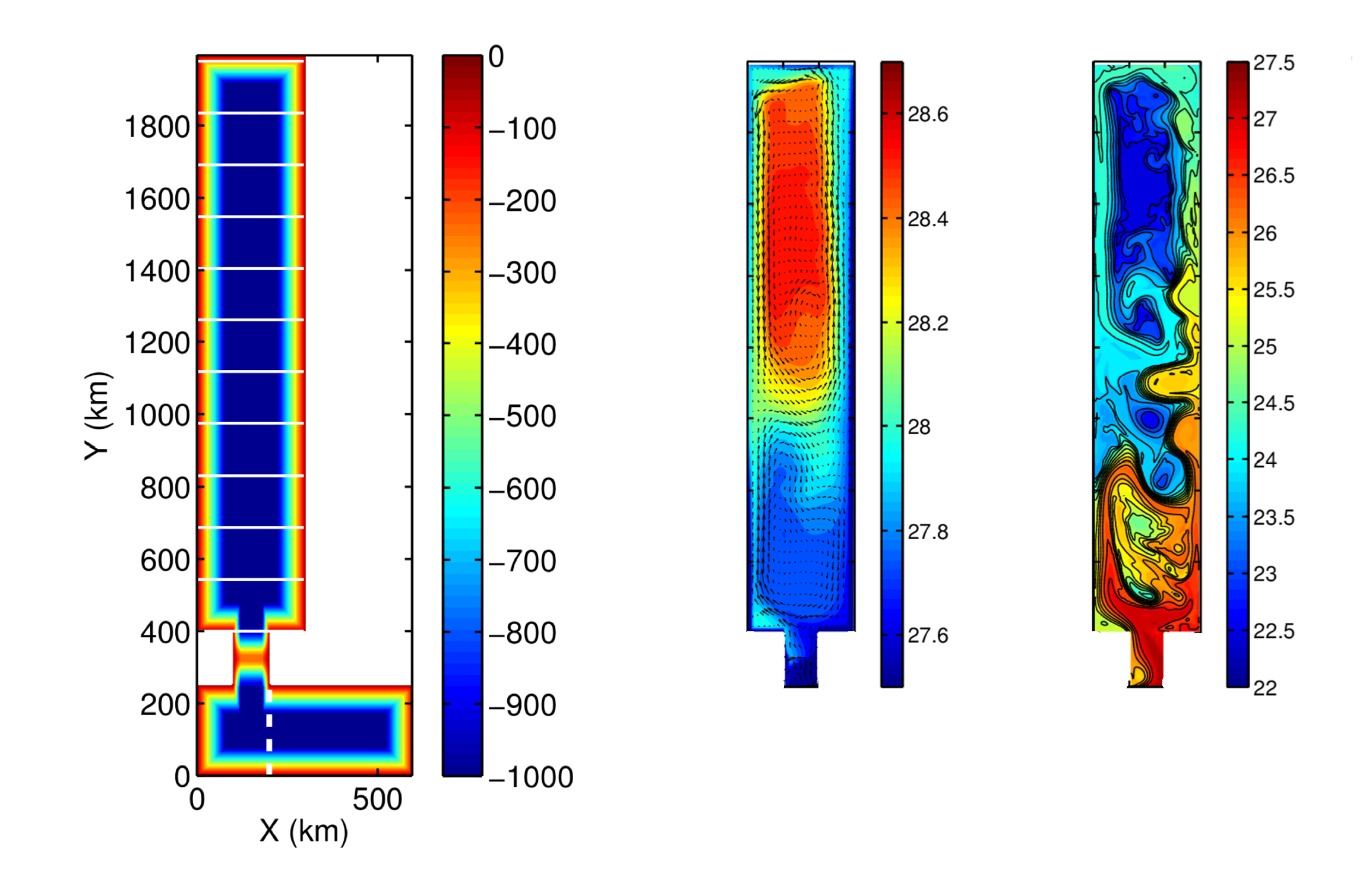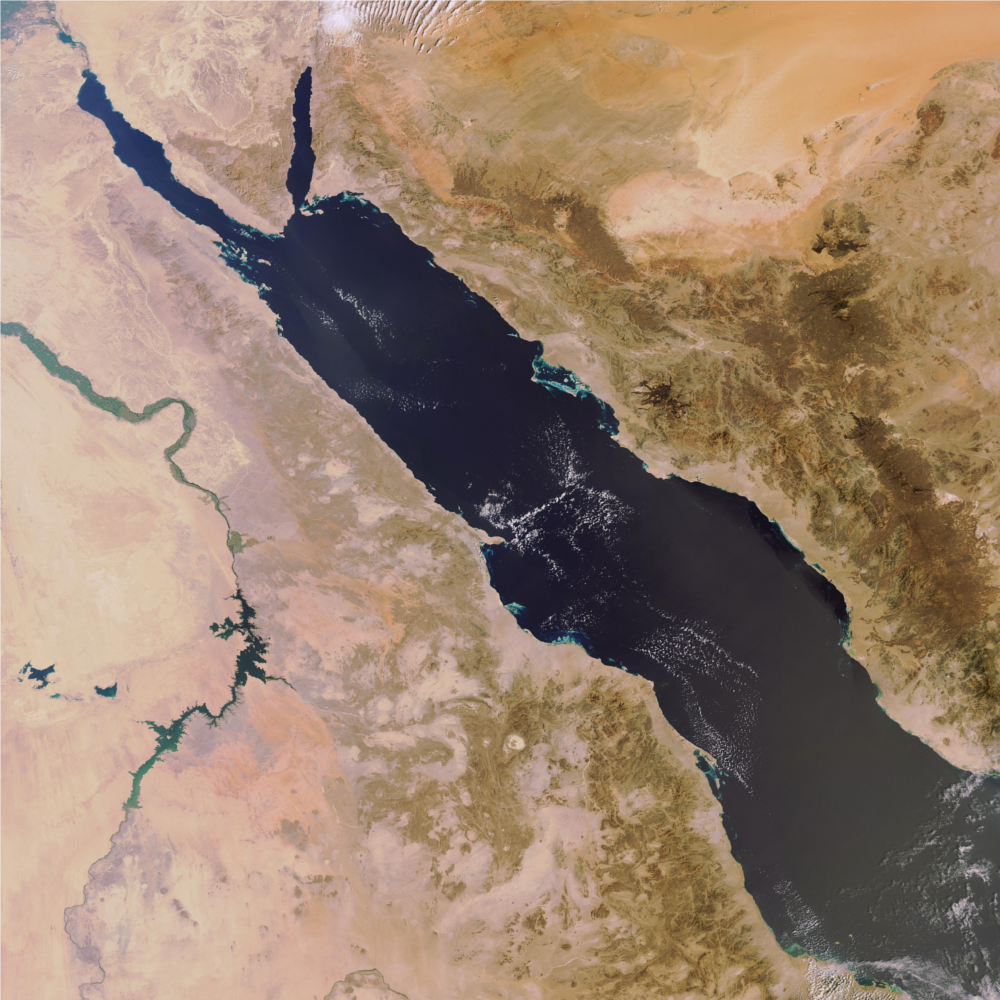story by Helen Hill

This month we take a closer look at work by recent MIT-WHOI Joint Program alumna Ping Zhai who has been using MITgcm to investigate the buoyancy driven circulation in the Red Sea and in particular the origin of a mid-basin cross-over current.
The Red Sea is effectively an ‘inverse estuary’ in which surface buoyancy loss far exceeds the gain due to freshwater input. The basin also exhibits a particularly narrow and elongated north-south geometry. Indeed the Coriolis parameter actually doubles from south to north with the result that zonal motions, while favored by the strong beta effect, are blocked by the narrow walls.
This work, which formed part of Zhai’s Phd thesis, focuses on understanding a west-to-east crossover of boundary currents seen in the mean circulation patterns from several past models of the Red Sea.

Idealized Red Sea Configuration and Resulting Circulation: (Left) The idealized domain (Middle) Mean density (color) and horizontal velocity (arrows) (Right) Snapshot of surface temperature – Zhai et al. 2015.
To probe the mechanisms that produce and control the cross-over, Zhai and co-authors WHOI Senior Scientists Larry Pratt and Amy Bower, set up an idealized, eddy-resolving, configuration of the MITgcm, forced by latitudinally varying buoyancy forcing – strong to the north, weaker to the south.
The resulting circulation consists of an anticyclonic boundary current in the southern Red Sea, and a cyclonic boundary current in the northern Red Sea, with northward surface flow crossing from the western boundary to the eastern boundary connecting the two at mid-basin.
Using their idealized model to study relevant parameter space, Zhai et al explored the crossover latitude dependence on Coriolis parameter, β and the meridional gradient of surface buoyancy forcing.
The authors find their results compare well with an analysis based on quasi-geostrophic, β-plane dynamics, which predicts the cross-over should lie at the latitude where the net potential vorticity advection (including an eddy component) is zero.
To find out more about this work contact Ping.

Ping Zhai, is a recent graduate of the MIT-WHOI Joint Program, now a Research Associate in the Ocean Observing and Modeling Group in the Department of Marine, Earth & Atmospheric Sciences at North Carolina State University, Raleigh, NC. When she is not hard at work modeling the ocean she enjoys snowboarding, diving, and surfing, and has recently become interested in pistol and rifle shooting. She also loves to bake.
This Month’s Featured Publication
- Ping Zhai, Larry J. Pratt, Amy Bower (2015), On the Crossover of Boundary Currents in an Idealized Model of the Red Sea, Journal of Physical Oceanography 2015 ; e-View, doi:10.1175/JPO-D-14-0192.1
Other New Publications this Month
Egor N. Churaev, Sergey V. Semin and Yury A. Stepanyants (2015) Transformation of internal waves passing over a bottom step, Journal of Fluid Mechanics / Volume 768 / April 2015, R3 (11 pages), doi: 10.1017/jfm.2015.92
Grue, John (2015) Nonlinear interfacial wave formation in three dimensions,
Journal of Fluid Mechanics, Volume 767, March 2015, pp 735- 762, doi: 10.1017/jfm.2015.42
Ada Gjermundsen, Joseph H. LaCasce, and Liv Denstad (2015) The buoyancy-driven ocean circulation with realistic bathymetry, Geophysical Research Abstracts, Vol. 17, EGU2015-12571, 2015, EGU General Assembly 2015
Yanli Jia, Ryo Furue, Julian P. McCreary Jr. (2015), Impacts of regional mixing on the temperature structure of the equatorial Pacific Ocean. Part 2: Depth-dependent vertical diffusion, Ocean Modelling
(in press), doi: 10.1016/j.ocemod.2015.02.007
Ala Khazendar, Christopher P. Borstad, Bernd Scheuchl, Eric Rignot, Helene Seroussi (2015), The evolving instability of the remnant Larsen B Ice Shelf and its tributary glaciers, Earth and Planetary Science Letters, Volume 419, 1 June 2015, Pages 199–210, doi: 10.1016/j.epsl.2015.03.014
T. Kuhlbrodt, J. M. Gregory, L. C. Shaffrey (2015), A process-based analysis of ocean heat uptake in an AOGCM with an eddy-permitting ocean component, Climate Dynamics
March 2015, doi: 10.1007/s00382-015-2534-0
Xiaoming Li, Lequan Chi, Xueen Chen, YongZheng Ren, Susanne Lehner (2015) SAR observation and numerical modeling of tidal current wake at the East China Sea offshore wind farm, 2014 DRAGON 3 Mid-term Results Symposium (26-29 May 2014) pdf
Camille Lique, Helen L. Johnson, and Peter E.D. Davis (2015), On the interplay between the circulation in the surface and the intermediate layers of the Arctic Ocean, Journal of Physical Oceanography 2015 ; e-View, doi: 10.1175/JPO-D-14-0183.1
Taira Nagai andToshiyuki Hibiya (2015), nternal tides and associated vertical mixing in the Indonesian Archipelago, Journal of Geophysical Research Oceans (accepted article), doi: 10.1002/2014JC010592
Cesar Rocha, Sarah Gille, Teresa Chereskin, Dimitri Menemenlis (2015), Inferring upper ocean dynamics from horizontal wavenumber spectra: Insights from Drake Passage, USCD Southern Ocean Dynamics Workshop poster
José C. Sánchez Garrido, C. Naranjo, D. Macías, J. García Lafuente, T. Oguz (2015), Modelling the Impact of Tidl Flows on the Biological Productivity of the Alboran Sea, ALBOREX Conference presentation
G. Sannino, A. Carillo, G. Pisacane, C. Naranjo (2015), On the relevance of tidal forcing in modelling the Mediterranean thermohaline circulation, Progress in Oceanography (in press), doi: 10.1016/j.pocean.2015.03.002
Edward Santilli, Alberto Scotti (2015), The Stratified Ocean Model with Adaptive Refinement (SOMAR), Journal of Computational Physics, Volume 291, 15 June 2015, Pages 60–81, doi: 10.1016/j.jcp.2015.03.008
Adam P. Showman, Nikole K. Lewis, and Jonathan J. Fortney (2015), THREE-DIMENSIONAL ATMOSPHERIC CIRCULATION OF WARM AND HOT JUPITERS: EFFECTS OF ORBITAL DISTANCE, ROTATION PERIOD, AND NONSYNCHRONOUS ROTATION, The Astrophysical Journal, Volume, 801, Number 2, doi: 10.1088/0004-637X/801/2/95
Michael Siccha, Eli Biton and Hezi Gildor(2015), Red Sea circulation during Marine Isotope Stage 5e, Paleoceanography Accepted Article, doi: 10.1002/2013PA002603
D. A. Slater, P. W. Nienow, T. R. Cowton, D. N. Goldberg and A. J. Sole (2015), Effect of near-terminus subglacial hydrology on tidewater glacier submarine melt rates, Geophysical Research Letters (early view), doi: 10.1002/2014GL062494
Lars H. Smedsrud, Torge Martin (2015), Grease ice in basin-scale sea-ice ocean models, Annals of Glaciology 56(69) 2015 doi: 10.3189/2015AoG69A765
H. C. B. Steel, C. P. McKay andD. T. Andersen (2015), Modeling circulation and seasonal fluctuations in perennially ice-covered and ice-walled Lake Untersee, Antarctica, Limnology and Oceanography (early view), doi: 10.1002/lno.10086
A.L. Stewart, A.F. Thompson (2015), The Neutral Density Temporal Residual Mean overturning circulation, Ocean Modeling (in press), doi: 10.1016/j.ocemod.2015.03.005
Alex Warn-Varnas, Dong S. Ko, Avijit Gangopadhyay (2015), Signatures of tidal interference patterns in the South China Sea, Journal of Oceanography, doi: 10.1007/s10872-015-0282-8
J. D. Wilson, A. Ridgwell, and S. Barker (2015), Can organic matter flux profiles be diagnosed using remineralisation rates derived from observed tracers and modelled ocean transport rates?Biogeosciences Discuss., 12, 4557–4593, doi: 10.5194/bgd-12-4557-2015
Varvara E. Zemskova, Brian L. White, and Alberto Scotti (2015) Available Potential Energy and the General Circulation: Partitioning Wind, Buoyancy Forcing, and Diapycnal Mixing, Journal of Physical Oceanography 2015; e-View, doi: 10.1175/JPO-D-14-0043.1
Xiangming Zeng, Yizhen Li, and Ruoying He (2015) Predictability of the Loop Current variation and eddy shedding process in the Gulf of Mexico using an artificial neural network approach, Journal of Atmospheric and Oceanic Technology 2015 ; e-View, doi: 10.1175/JTECH-D-14-00176.1
Do you have news about research using MITgcm? We are looking for contributions to these pages. If you have an interesting MITgcm project (ocean, atmosphere, sea-ice, physics, biology or otherwise) that you want to tell people about, get in touch. To make a post, contact Helen

